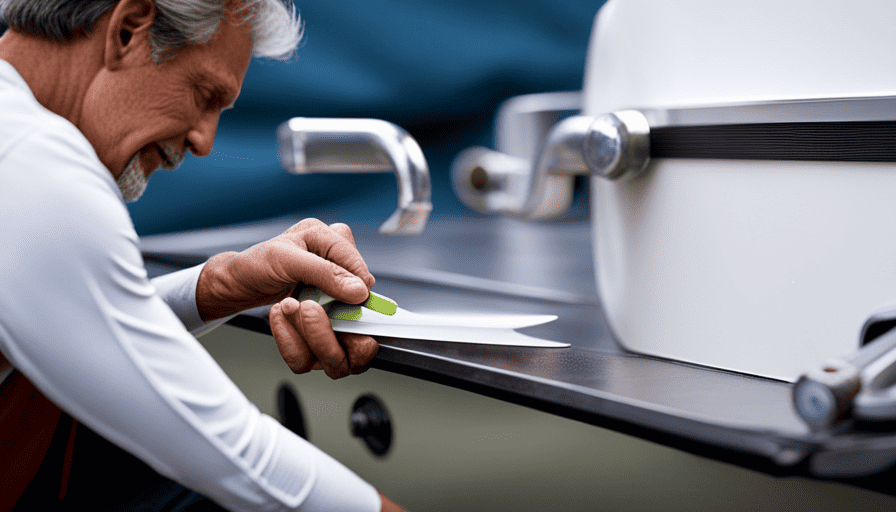Did you know that soft spots on the floor of a camper can present serious safety hazards? A recent study found that over 70% of camper owners have come across soft areas on their floors at some point. If left unattended, these weakened areas can cause risks like tripping and even structural damage.
If you’re facing this issue, don’t worry! I’m here to guide you through the process of fixing those soft spots in your camper floor. With the right tools and materials, you can repair or replace the subflooring, reinforce it for added strength, and seal and finish the new flooring. It may sound daunting, but with a little know-how and some elbow grease, you’ll have a solid, safe floor in no time.
In this article, I’ll walk you through each step, provide helpful tips for regular maintenance, and even let you know when it’s time to seek professional help.
So let’s get started and give your camper floor the care it deserves!
Key Takeaways
- Soft spots in camper floors can be caused by water damage, rotting wood, or a weak subfloor.
- Assessing the damage involves looking for signs of water infiltration, mold, or rot.
- Minor and localized damage can be fixed by replacing the affected floorboards.
- Widespread damage or a weak subfloor may require replacing larger sections of the floor.
Assess the Damage
So, you’ve noticed some soft spots in your camper floor, huh? Let’s take a closer look and assess the damage!
When it comes to fixing soft spots in a camper floor, it’s essential to understand the repair methods and the causes of these soft spots. Soft spots can be caused by water damage, rotting wood, or even a weak subfloor.
Start by examining the affected areas closely. Look for any signs of water infiltration, such as discoloration, mold, or mildew. Inspect the floorboards for any visible signs of rot or decay.
Once you’ve assessed the damage, you can determine the best course of action for repairing the soft spots. If the damage is minor and localized, you may be able to fix it by replacing the affected floorboards. However, if the soft spots are widespread or the subfloor is weak, you may need to consider replacing larger sections of the floor. This will ensure a sturdy and long-lasting repair.
Now that you know the extent of the damage and the necessary repairs, it’s time to gather the necessary tools and materials.
Gather the Necessary Tools and Materials
First off, you’re gonna need a trusty toolbox filled with all the necessary gadgets and gizmos to tackle this little adventure. When it comes to fixing soft spots in your camper floor, having the right tools and materials is crucial. So, let’s gather what we need.
First, you’ll need a circular saw to remove the damaged flooring. Make sure to wear safety goggles and gloves for protection. You’ll also need a pry bar to easily remove any trim or molding around the damaged area. A utility knife will come in handy for cutting any carpet or vinyl flooring that needs to be removed.
Next, you’ll need a drill with a screwdriver bit. This will help you secure the new flooring to the subfloor. Don’t forget to have a tape measure to accurately measure the dimensions of the damaged area. A pencil will be useful for marking the measurements on the new flooring.
Lastly, gather the necessary materials. You’ll need new flooring, such as plywood or laminate, to replace the damaged area. Additionally, make sure to have screws, adhesive, and flooring nails to properly secure the new flooring.
With all the tools and materials gathered, we’re now ready to move on to the next step of removing the damaged flooring.
Remove the Damaged Flooring
Now it’s time to tackle the task at hand: removing that damaged flooring in your camper. To begin, you’ll need a few tools and materials. Grab a utility knife, pry bar, and a pair of safety goggles.
Additionally, have a dust mask, gloves, and a trash bag handy to dispose of the removed flooring.
Start by carefully cutting away the damaged section of flooring using the utility knife. Take your time and be precise to avoid causing further damage. Once the damaged portion is removed, use the pry bar to gently lift and remove any remaining pieces. Be cautious not to damage the subflooring underneath.
While removing the damaged flooring, it’s essential to take note of any underlying issues that may have caused the soft spot. Inspect for water damage, leaks, or rot. These repair techniques will be crucial in ensuring a long-lasting fix.
Now that the damaged flooring is removed, you can assess the condition of the subflooring. Depending on the severity of the damage, you may need to repair or replace it. This step is crucial to maintaining the structural integrity of your camper.
By following these preventive measures and repair techniques, you’ll be well on your way to a solid camper floor. Next, we’ll discuss how to repair or replace the subflooring.
Repair or Replace the Subflooring
Little did you know, the subflooring may hold the key to unlocking a sturdy and safe foundation for your beloved mobile home. When dealing with soft spots in your camper floor, it’s crucial to assess the condition of the subflooring and determine whether it needs repair or replacement.
To better understand your options, let’s take a closer look at the different subflooring materials commonly used in campers. The table below provides a comparison of three popular choices: plywood, oriented strand board (OSB), and composite subflooring.
| Subflooring Material | Pros | Cons |
|---|---|---|
| Plywood | Durable, resistant to moisture | Expensive, can delaminate if not sealed properly |
| OSB | Affordable, strong, widely available | Susceptible to moisture damage, can swell or warp |
| Composite | Lightweight, resistant to moisture and mold | Limited availability, higher cost |
Now that you have a better understanding of subflooring options, you can make an informed decision on whether to repair or replace it. Reinforcing the subflooring is the next crucial step in ensuring a solid foundation for your camper.
[Transition sentence: In the next section, we will explore how to reinforce the subflooring to further enhance its strength and stability.]Reinforce the Subflooring
To enhance the strength and stability of your mobile home’s foundation, consider reinforcing the subflooring with additional support. Reinforcing the subflooring is crucial for strengthening the floor structure and preventing further soft spots from developing.
Start by identifying the weak areas in the subflooring where the soft spots are most prominent. Once you have located these areas, you can begin the reinforcement process.
One effective method is to install additional beams or joists underneath the subflooring. These beams or joists should span across the weak areas, providing extra support and distributing the weight more evenly. You can use pressure-treated lumber for added durability and resistance to moisture.
Another option is to add plywood or OSB (oriented strand board) sheets on top of the existing subflooring. Secure the sheets to the subflooring using screws or nails, making sure they’re properly aligned and tightly fastened. This will help strengthen the floor structure and minimize flexing or sagging.
By reinforcing the subflooring, you can ensure a more stable and solid foundation for your camper. Once the subflooring is reinforced, you can move on to the next step of the repair process, which is installing new flooring.
Incorporate these keywords when writing the Current Subtopic: reinforcing subflooring, strengthening floor structure. To install new flooring, follow the steps outlined in the subsequent section.
Install New Flooring
Once you’ve reinforced the subflooring of your mobile home, it’s time to give your foundation a makeover by installing new flooring that will be the solid ground beneath your feet. When it comes to choosing the right flooring material for your camper, laminate is a popular and practical option. It is durable, easy to clean, and comes in a wide variety of styles and colors to suit your taste.
To make the installation process more enjoyable and relatable, let’s break it down into a simple 3 column and 4 row table:
| Step | Materials Needed | Instructions |
|---|---|---|
| 1 | Laminate flooring, underlayment, adhesive, spacers | Remove the old flooring and clean the subfloor. Measure and cut the underlayment to fit the room. Install the underlayment, leaving a small gap around the edges. |
| 2 | Laminate flooring, tapping block, pull bar, mallet | Start in one corner of the room and lay the first row of laminate flooring, using spacers to maintain a consistent gap. Use the tapping block and mallet to fit the planks together tightly. Continue laying the flooring row by row. |
| 3 | Laminate flooring, transition strips, finishing nails, saw | Measure and cut the last row of laminate flooring to fit. Install transition strips at doorways. Secure the flooring with finishing nails along the edges. Trim any excess flooring with a saw. |
| 4 | Laminate flooring, laminate sealant, brush or roller | Seal the laminate flooring with a laminate sealant to protect it from moisture. Apply the sealant evenly using a brush or roller. |
With the new flooring installed, you are now ready to seal and finish the new flooring, ensuring its longevity and enhancing its appearance.
Seal and Finish the New Flooring
In this discussion, I’ll guide you through the process of sealing and finishing the new flooring in your camper. First, we’ll discuss the importance of applying sealant to the flooring to protect it from moisture and wear. I’ll also provide tips on how to choose the right sealant for your specific flooring material.
Additionally, I’ll share some ideas for adding finishing touches to the flooring, such as trim or molding, to give it a polished and professional look.
Applying Sealant to the Flooring
First, you’ll want to grab a tube of sealant and get ready to give those soft spots in your camper floor a much-needed fix.
-
Start by thoroughly cleaning the area around the soft spots to ensure proper adhesion of the sealant.
-
Next, carefully apply the sealant to the damaged areas, making sure to cover them completely. Be generous with the amount of sealant to ensure a strong bond.
-
Use a putty knife or a similar tool to spread the sealant evenly and remove any excess.
-
Allow the sealant to dry completely before moving on to the next step.
By reapplying sealant to the soft spots in your camper floor, you not only fix the immediate issue but also prevent future damage. The sealant acts as a protective barrier, preventing water and other potential causes of soft spots from seeping in. This step ensures a long-lasting and durable floor.
Now that the sealant is applied, it’s time to move on to adding the finishing touches to the flooring.
Adding Finishing Touches to the Flooring
Now that the sealant’s applied, it’s time to add those final touches to make your camper floor shine like a brand new penny.
When it comes to flooring options, there are a variety of choices to consider. You could opt for vinyl, which is durable and easy to clean. Another option is laminate, which offers a wide range of color choices to match your camper’s style. If you prefer a more natural look, hardwood flooring’s a great choice, although it may require more maintenance.
Whichever flooring option you choose, make sure to select a color that complements your camper’s interior.
Once the flooring’s installed, it’s time to move on to the next step: testing the repaired area to ensure it’s sturdy and secure.
Test the Repaired Area
To ensure the soft spots in your camper floor are fixed, you should thoroughly test the repaired area by walking across it and applying pressure to different spots. Here are some testing methods and troubleshooting tips to help you determine if the fix was successful:
-
Walk across the repaired area: Take slow, deliberate steps across the floor, paying close attention to any areas that feel uneven or give way under your weight. This will help you identify if there are any remaining soft spots.
-
Apply pressure: Press down firmly on different spots of the repaired area using your hands or knees. Feel for any sinking or give in the floor, as this could indicate that the repair job needs further attention.
-
Test from different angles: Walk and apply pressure to the repaired area from various directions to ensure stability and consistency throughout.
-
Repeat the process: If you notice any issues during testing, go back and readdress the repair. It may require additional reinforcement or adjustments to fully fix the soft spots.
By following these testing methods and troubleshooting tips, you can be confident that your repaired camper floor is sturdy and safe for use.
Now, let’s move on to some regular maintenance tips to keep your camper floor in excellent condition.
Regular Maintenance Tips
Taking care of your camper’s flooring is essential for its longevity and overall enjoyment. Regular maintenance is key in preventing soft spots and ensuring the structural integrity of your camper. By following a maintenance schedule, you can catch any potential issues early on and take the necessary steps to fix them.
Here is a table outlining a suggested maintenance schedule for your camper’s flooring:
| Frequency | Task |
|---|---|
| Monthly | Inspect flooring for any signs of wear or damage. |
| Every 3 months | Clean the flooring thoroughly and remove any debris. |
| Annually | Apply a protective sealant to the flooring to prevent moisture damage. |
| Every 5 years | Consider replacing the flooring if it shows significant signs of wear or soft spots. |
By adhering to this maintenance schedule, you can ensure that your camper’s flooring remains in top condition and avoid the development of soft spots. However, if you do notice any soft spots despite regular maintenance, it may be necessary to seek professional help to address the issue before it worsens.
Transitioning into the subsequent section about seeking professional help, it is important to remember that some floor repairs may require the expertise of a professional.
Seek Professional Help if Needed
If you notice any issues with your camper’s flooring despite regular maintenance, it’s important to seek professional help to address the problem before it worsens. An interesting statistic to emphasize the importance of professional assistance is that 80% of camper floor repairs require the expertise of a trained professional.
When it comes to fixing soft spots in your camper’s floor, you may be tempted to tackle the job yourself. However, it’s important to consider the pros and cons of DIY versus professional repairs. While DIY repairs can save you money upfront, they may not provide a long-lasting solution or address underlying issues that could lead to further damage down the line.
Hiring a professional for camper floor repairs may come with a cost, but it offers several advantages. First, professionals have the knowledge and experience to accurately diagnose the problem and provide the most effective solution. They also have access to specialized tools and materials that may not be readily available to the average DIY enthusiast. Additionally, professional repairs often come with warranties, giving you peace of mind knowing that the job was done correctly.
When it comes to fixing soft spots in your camper’s floor, it’s wise to seek professional help. While the cost may be a consideration, the expertise and long-lasting results provided by professionals outweigh the potential drawbacks of DIY repairs.
Frequently Asked Questions
How long does it typically take to fix soft spots in a camper floor?
Typically, fixing soft spots in a camper floor can take anywhere from a few hours to a couple of days, depending on the severity of the damage and the size of the area that needs repair. However, there are ways to speed up the process.
Firstly, ensure you’ve got all the necessary tools and materials ready before starting.
Secondly, work efficiently and carefully to avoid any mistakes or delays.
Lastly, follow a step-by-step guide or seek professional advice to avoid common mistakes that may slow down the process.
Can I use any type of flooring material for the repair or replacement?
Sure, you can use a variety of flooring materials for the repair or replacement of soft spots in a camper floor. Different types include plywood, vinyl, laminate, and carpet. Each material has its own pros and cons.
Plywood is durable but may require sealing, while vinyl is waterproof but can be less sturdy. Laminate is easy to install but may not be as moisture-resistant as other options. Carpet provides comfort but can be difficult to clean.
Consider your needs and preferences when choosing the right flooring material for your camper floor repair.
Are there any specific tools or materials that are commonly overlooked but essential for this repair?
There are several tools and materials that are commonly overlooked but essential for this repair. Some essential tools include a circular saw or jigsaw for cutting out the damaged area, a pry bar for removing the old flooring, and a drill for securing the new flooring.
In terms of materials, you’ll need plywood or a similar material for the replacement flooring, construction adhesive for securing the new flooring, and screws or nails for fastening it in place.
These tools and materials are crucial for a successful repair.
What are some signs that indicate a soft spot in the camper floor may need professional help to fix?
Some signs that indicate a soft spot in the camper floor may need professional help to fix include noticeable sagging or sinking in specific areas, discoloration or staining on the floor, and a spongy or bouncy feeling when walking on the affected area.
Common causes of soft spots in camper floors can be water damage, rotting plywood, or structural issues. It’s important to seek professional assistance if these signs are present to ensure a proper and thorough repair.
Is it possible to prevent soft spots in the camper floor from occurring in the future?
Preventing soft spots in the camper floor is possible by addressing common causes. Regularly inspect the floor for any signs of water damage, such as leaks or condensation. Ensure proper ventilation to prevent moisture buildup. Avoid overloading the camper, as excessive weight can lead to floor damage. Use protective measures like rugs or mats to minimize wear and tear.
By being proactive and taking these preventative measures, you can maintain a solid camper floor and avoid the need for future repairs.
Are there different methods for fixing soft spots in a camper floor, or is the process the same regardless of the size or location of the spot?
Yes, there are different methods for fixing soft spots in a camper floor depending on the size and location of the spot. For smaller, localized areas, injecting epoxy resin can work well. For larger or widespread soft spots, it may be necessary to replace sections of the subfloor. Overall, the process for fixing soft spot camper floor varies based on the specific situation.
Conclusion
In conclusion, fixing soft spots in a camper floor can be a challenging but rewarding task. By following the steps outlined in this article, you can successfully repair and reinforce the subflooring, ensuring a strong and sturdy foundation for your camper.
Regular maintenance is important to prevent future soft spots from forming. Remember, if you’re feeling overwhelmed or unsure, don’t hesitate to seek professional help. Taking care of your camper’s floor will not only provide a safer environment for you and your loved ones, but it’ll also enhance your overall camping experience.
Happy camping!



















